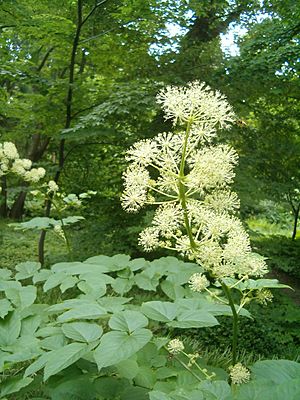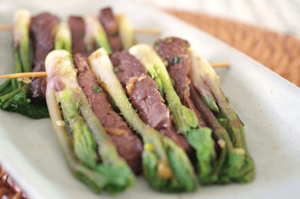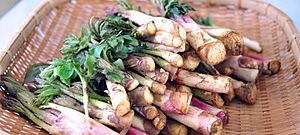Aralia cordata facts for kids
Quick facts for kids Aralia cordata |
|
|---|---|
 |
|
| Scientific classification | |
| Genus: |
Aralia
|
| Species: |
cordata
|
Aralia cordata is a tall plant that grows up to 2 to 3 meters (6.5 to 10 feet) high. It is a type of herbaceous perennial plant, which means it has soft stems and comes back year after year. This plant is originally from Japan, Korea, and eastern China.
People call it by many names, like spikenard, herbal aralia, udo (in Japanese), Japanese spikenard, and mountain asparagus. You can often find it growing on the sides of wooded hills. Aralia cordata belongs to the Aralia group, which is part of the Araliaceae family, also known as the ivy family.
Every spring, the plant grows new shoots. These shoots are often blanched (lightly cooked) and eaten as a vegetable. In Korea, people have used the dried root of this plant as traditional medicine for a long time. The young shoots have a strong, but pleasant, smell and taste. Besides being used for food and medicine, Aralia cordata is also grown as a pretty plant in gardens.
Contents
What Does Aralia Cordata Look Like?
Aralia cordata is a type of plant called a dicot. This means its seeds have two main leaves when they sprout. Its leaves grow in an alternating pattern along the stem. They are large and divided into many smaller leaflets. Each leaflet is about 7 to 15 cm (3 to 6 inches) long and 5 to 10 cm (2 to 4 inches) wide.
In late summer, the plant produces many small, white flowers. These flowers grow in large, round clusters called umbels, which can be 30 to 45 cm (12 to 18 inches) across. After the flowers, small black fruits appear. These fruits are like tiny drupes, about 3 mm (0.1 inches) wide. They might be harmful if eaten by humans.
In the wild, this plant can grow to be about 1.2 to 1.8 meters (4 to 6 feet) tall. In spring, its leaves are golden, and in summer, they turn a bright green. It has a thick root system with shoots that can be 60 to 90 cm (2 to 3 feet) long. The plant grows best in rich soil. In summer, it also produces loose bunches of flowers, about 90 cm (3 feet) long. These flowers attract bees and flies, which is helpful for beekeepers. You can grow Aralia cordata from seeds or by taking cuttings from the plant.
History of Aralia Cordata
Aralia cordata has been widely grown for food in Japan for a long time. In the early 1900s, it was brought to the United States. However, it did not become a very popular commercial crop there. In Korea, the dried root of the plant has been used in traditional medicine to help with swelling, fever, and pain.
How to Grow Aralia Cordata
Growing Conditions
You can grow Aralia cordata in different types of soil, like normal garden soil, sandy soil, or clay soil. The soil should be neutral or slightly acidic, with a pH between 5.0 and 7.5. If you have clay or sandy soil, adding organic material (like compost) can help. This plant is easy to grow and does not need much fertilizer.
It grows very quickly, reaching its full size of 1.8 to 2.7 meters (6 to 9 feet) tall and wide in just one growing season. It can handle cold temperatures in winter because it dies back to the ground and then regrows in the spring. It can keep producing shoots for six years or more. The plant doesn't need much work, but its shoots need to be blanched if you want to eat them.
Aralia cordata needs a climate with little to no dry spells. It grows well in moist and rainy areas, including mountains. While it often grows wild, you can also grow it in fields, cellars, or plant nurseries. The plant prefers light shade, but it can also grow in full shade or full sun, as long as it gets enough water.
Growing the plant from seeds takes several months of stratification. This means the seeds need to be kept cold and moist to help them sprout. Seeds usually don't sprout well right after being picked or if stored dry. However, they sprout much better in cold, moist sand. Cold treatments help the seeds wake up and grow. Seeds from cultivated plants tend to sprout better than those from wild plants. The plant also spreads easily by growing new shoots from its roots, so it can keep producing plants forever.
Plant Health and Diseases
Sometimes, Aralia cordata can get diseases. One disease is called "Rootrot." This disease attacks the stems and roots. You might only notice it when the plant is three-quarters grown. For large plants with many stems, the leaves slowly wither from the bottom up, and the plant can take a whole growing season to die. The leaves and stems turn brown, and the roots rot, often with large black fungi. For small plants, the leaves wilt, the leaf stalks rot, and the stems decay until the whole plant breaks down. In humid conditions, a lot of white fungus can grow on the outside.
Insects and rodents might spread the fungus. Or, infected soil can get into the roots through tiny root hairs, dead roots, or cuts from gardening. To prevent this, choose land where similar plants haven't been sick before. Grow plants from seeds to avoid contamination from root cuttings. Always wash your gardening tools, and be careful about what you and your animals bring into the garden. Try to avoid cutting the plants too much while they are growing. If a field gets infected, it's best not to grow Aralia cordata there for several years. People knew how to control this disease in 1923, but they didn't know if some types of the plant were more resistant than others.
Another disease is "Wilt." This disease makes the leaves turn yellow, then brown, and eventually dry up. The leaf stalks die but often stay attached to the stems for a long time. If a field is infected, it's better to use a different field with thick soil, as Wilt causes less damage there. To prevent and control Wilt, it's a good idea to remove dead, old, or diseased plants, soil, and compost. At the end of the growing season, sort through the soil and plants to reduce the risk of diseases building up.
Plant Varieties
There are different types of Aralia cordata plants found in the provinces of China, but more research is needed to understand them fully. Aralia cordata and Aralia hispida are genetically similar. This is because long ago, Eastern Asia and North America were connected, allowing plant species to move between them.
Plants from northern areas are less developed, with smaller stem hairs, fewer nodes (where leaves grow), side shoots, and leaves than plants from southern areas. This might be because they bloom earlier. Plants grown in gardens (domestic stocks) don't have as much variety, but they are similar to wild plants from the south, which have shorter resting periods.
How People Use Aralia Cordata in Cooking
In Japan
In Japan, the edible stem of Aralia cordata is sometimes boiled and added to miso soup. Even though Aralia cordata can grow quite large, it's not a woody plant. Its stem is very soft, so it cannot be used for lumber. Also, the stems become too tough to eat if they grow too big. This fact is part of a popular Japanese saying, udo no taiboku (独活の大木), which means "great tree of udo." It's used to describe a person or thing that is useless despite being large.
Young stems from the roots are eaten in soups and salads. It's important to cook them properly because raw stems have a resin (a sticky substance) that tastes like pine. Before eating, you should slice them thinly and boil them a few times, or soak them in cold water for an hour. This helps remove the resin. The stems can be cooked in a similar way to asparagus.
In Korea

In Korean, the plant is called ttangdureup (땅두릅), which means "land angelica." Young spikenard shoots are picked for about a month, from early April to early May, when they are soft and smell nice. In Korean cuisine, these shoots are often eaten in different ways:
- As namul, which means they are blanched (quickly boiled) and seasoned.
- Pickled as jangajji.
- Pan-fried as jeon.
- Grilled as sanjeok.
In Imsil County, people also use them in maeuntang (spicy fish stew).
Here are some popular Korean dishes made with ttangdureup:
- Ttangdureup-jangajji – This is a type of jangajji (pickle). The spikenards are blanched and then pickled. The pickling sauce is made by boiling soy sauce, water, maesil-cheong (plum syrup), sugar, and vinegar with kelp, then letting it cool.
- Ttangdureup-jeon – This is a type of jeon. The spikenards are blanched, coated with starch and egg, and then pan-fried in oil.
- Ttangdureup-maeun-tang – This is a type of maeun-tang (spicy soup). It's made with freshwater fish like Amur catfish. In Imsil County, spikenards are used instead of siraegi (dried radish greens) in maeuntang recipes. To make the stew, fish is boiled with large pieces of radish. Then, spikenards, onion, aehobak, Java waterdropwort, oyster mushrooms, red chili, and spicy sauce are added. The spicy sauce is usually made the day before and kept in the fridge overnight. It can be made by mixing gochujang (chili paste), doenjang (bean paste), gochugaru (chili powder), toasted perilla seeds, minced garlic, and ground ginger.
- Ttangdureup-muchim – This is a type of namul. The shoots are blanched in salted water and then seasoned with soup soy sauce, chopped scallions, minced garlic, sesame oil, and toasted sesame seeds.
What Nutrients Does Aralia Cordata Have?
For every 100 grams of raw stem, Aralia cordata contains:
- 220 mg of potassium
- 7 mg of calcium
- 9 mg of magnesium
- 25 mg of phosphorus
- 0.2 mg of iron
- 0.1 mg of zinc
- 4 mg of vitamin C
Economic Importance
Aralia cordata is very popular in Korea and Japan. It is also grown in North America for special dishes and as a decorative plant. It has a lot of potential for use in medicine to help reduce fever and other sickness symptoms. In China, the root is often used as a replacement for ginseng, which is another plant in the Araliaceae (ivy) family.
The resinous taste of Aralia cordata means it needs to be cooked, soaked, or peeled before eating. This might be why it's not more widely used.
See also
 In Spanish: Aralia cordata para niños
In Spanish: Aralia cordata para niños


